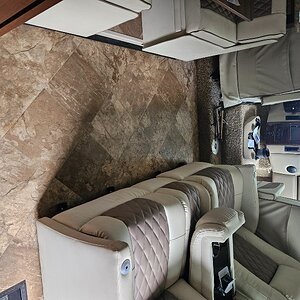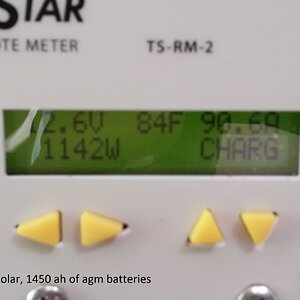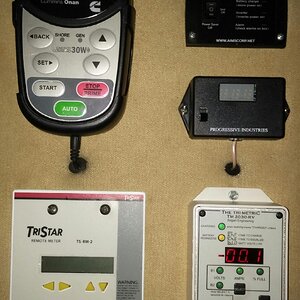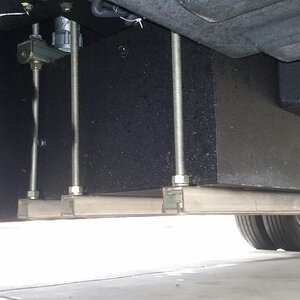turbopilot
RVF Supporter
- Joined
- Nov 2, 2019
- Messages
- 672
- Location
- Prescott, AZ
- RV Year
- 2026
- RV Make
- LightShip
- RV Model
- AE.1 Cosmos
- RV Length
- 26
- Engine
- Electric
- TOW/TOAD
- 2025 Ford F-150 PowerBoost HEV
- Fulltimer
- No
LightShip began with an idea to make it realistic to tow an RV with an EV tow vehicle. When the company was founded the typical EV pickup could only tow a high profile RV towable about 90 miles before needing to be recharged. Through the combination of aerodynamic improvements and the introduction of an electric motor in the RV, the LightShip is able to return full range to an EV tow vehicle. The downside is that to make this happen you will have to charge two EV's every 200 to 300 miles. Better than the alternative but not a complete win.
As the LightShip concept evolved into full scale testing it became clear that all the efficiency advantages offered to EV tow vehicles applied equally to HEV and pure ICE tow vehicles, but with an additional upside. HEV and ICE tow vehicles nominally have at least two to three times the range of EV tow vehicles when they are not towing. This difference allows an owner of an HEV or ICE tow vehicle to leverage the efficiency of the LightShip with more degrees of freedom, since most HEV's and ICE vehicles have a LightShip towing range without TrekDrive equal to or better than an EV towing LightShip with TrekDrive active.
LightShip has been testing their prototypes with three tow vehicles: a Rivian pickup, a Ford F-150 PowerBoost pickup and a Ford F-350 diesel pickup. They offer a unique range of attributes to complement the inherent efficiency of the LightShip, but in different ways.
I am going to be towing my LightShip with an 2025 F-150 PowerBoost hybrid with the optional 7.2 kWh Propower on Board inverter generator system. The Ford F-150 PowerBoost uses a parallel hybrid system. This setup integrates a gasoline engine and an electric motor in a way that allows them to work together, providing a seamless blend of power from both sources. The electric motor is sandwiched between the engine and the transmission, allowing it to assist the gasoline engine during acceleration and even provide short bursts of all-electric power.
The F-150 PowerBoost is not a plug-in hybrid. It uses a small 1.5 kWh LFP battery to buffer electrical energy. The battery can be charged by the engine, the drive train (regenerative braking) or both at the same time. There is no way to charge the battery externally. Depending on the power demand, the power in the battery can drive the wheels either alone or together with the ICE. All of this versatility is made possible by the hybrid module located between the ICE and the transmission.
While the small battery is a good fit to improve efficiency of the F-150 PowerBoost when not towing, it was not designed to capture all the energy available to recapture when towing a heavy trailer. The result is that when towing any heavy traditional trailer or LightShip with TrekDrive Off, is that a significant amount of regenerative energy is lost to the F-150 PowerBoost because the battery will quickly go to full capacity when slowing down the rolling mass of the F-150 and a heavy trailer in tow.
But for the F-150 PowerBoost, with the 7.2 kWh inverter generator, there is a way to capture some of the excess regenerative energy created by the PowerBoost traction motor. In addition the PowerBoost ICE engine can turn the traction motor to generate electricity via the inverter. The 7.2 kWh inverter generator uses electricity available on the high voltage battery bus, so anytime the PowerBoost battery nears full capacity the generator, if in use, will capture that energy and turn it into 220 volt AC electricity. That electricity can be supplied to LightShip by an umbilical connection into the NACS port. The result is that some regenerative energy will be salvaged from the PowerBoost for the LightShip if the PowerBoost battery is at or near capacity. And if excess regenerative energy is not available on the buss the PowerBoost will simply convert gasoline to electricity with the ICE turning the traction motor.
How much electrical energy can be salvaged from the PowerBoost will have to be considered with further testing. There is one concern harvesting this energy. Current LightShip firmware will not allow the NACS port to be active if TrekDrive is ON. So the harvest of PowerBoost excess regenerative electricity can only go to the LightShip battery when TrekDrive is OFF. It is not clear whether this is a hardware constraint or hopefully a firmware constraint that could be fixed in the future.
But it is always possible to move 7.2 kWh of energy to LightShip battery by using the PowerBoost ICE to burn gasoline to turn the traction motor, either in motion or sitting still as the PowerBoost idles. When sitting still the PowerBoost Inverter Generator will burn between .9 gph to 1.1 gph at a fully rated output of 7.2 kWh. The amount of gasoline burned in motion by the inverter generator will be less, offset by the amount of regenerative braking energy harvested by the traction motor.
Below is a schematic of the PowerBoost system. For model years 2024 and beyond the belt driven starter has been deleted. And below that is a very good YouTube video showing a tear down of the major transmission components of the PowerBoost Hybrid System.
Last edited:












